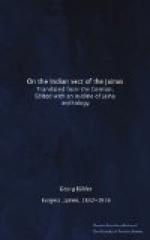to the Vairi [’s]akha. Mutilated
or wrongly written, the first word occurs also in inscriptions
Nos. 2, 6 and 9 as koto-, ke[t.][t.]iya, and
ka ..., the second in No. 6 as Vora.
One of the families of this ga[n.]a, the Va[n.]iya
kula is mentioned in No. 6, and perhaps in No.
4. The name of a second, the Pra[’s]navaha[n.]aka,
seems to have appeared in No. 19. The last inscription
mentions also another branch of the Ko[t.]iya ga[n.]a,
the Majhima sakha, which, according to the
Kalpasutra, was founded by Priyagantha the second
disciple of Susthita. Two still older schools
which, according to tradition, sprang from the fourth
disciple of the eighth patriarch, along with some
of their divisions appear in inscriptions Nos. 20 and
10. These are the Aryya-Udehikiya ga[n.]a,
called the school of the Arya-Roha[n.]a in the Kalpasutra,
to which belonged the Parihasaka kula and the
Purnapatrika [’s]akha, as also the Chara[n.]a
ga[n.]a with the Pritidharmika kula. Each
of these names is, however, somewhat mutilated by
one or more errata in writing. [Footnote: Dr.
Buehler’s long note (p. 48) on these inscriptions
was afterwards expanded in the Wiener Zeitschrift
fur die Kunde des Morgenlandes Bd. I, S.
165-180; Bd. II, S. 141-146. Bd. III,
S. 233-240; and Bd. IV, S. 169-173. The
argument of these papers is summarised in. Appendix.
A, pp. 48 ff.—Ed.] The statements in the
inscriptions about the teachers and their schools are
of no small importance in themselves for the history
of the Jainas. If, at the end of the first century
A.D.(?) many separate schools of Jaina ascetics existed,
a great age and lively activity, as well as great care
as regards the traditions of the sect, may be inferred.
The agreement of the inscriptions with the Kalpasutra
leads still further however: it proves on the
one side that the Jainas of Mathura were [’S]vetambara,
and that the schism, which split the sect into two
rival branches occurred long before the beginning
of our era. On the other hand it proves that the
tradition of the Svetambara really contains ancient
historic elements, and by no means deserves to be
looked upon with distrust. It is quite probable
that, like all traditions, it is not altogether free
from error. But it can no longer be declared
to be the result of a later intentional misrepresentation,
made in order to conceal the dependence of Jainism
on Buddhism. It is no longer possible to dispute
its authenticity with regard to those points which
are confirmed by independent statements of other sects,
and to assert, for example, that the Jaina account
of the life of Vardhamana, which agrees with the statements
of the Buddists, proves nothing as regards the age
of Jainism because in the late fixing of the canon
of the [’S]vetambaras in the sixth century after
Christ it may have been drawn from Buddhist works.
Such an assertion which, under all circumstances,
is a bold one, becomes entirely untenable when it is
found that the tradition in question states correctly
facts which lie not quite three centuries distant
from Vardhamana’s time, and that the sect, long
before the first century of our era kept strict account
of their internal affairs. [Footnote: See Weber’s
and Barth’s opinions quoted above in note I,
p. 23.]




